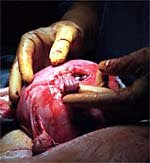Wednesday, July 30, 2008
During my last call duty we've delivered two cases of fetal hydrops by emergency cesarean section. The second one we sectioned at midnight. It's heavy-duty work on Neonatology team I have to say; but thumbs up to them with all arrangements they made in the middle of the night for this very fragile baby; one NICU staff at the head of the bed intubating; while additional two Neonatologists on each side of the baby's chest draining those pleural effusions.. very impressive work ! It just spoke of what ' Team Work ' really means !
I didn't post 2-D ultrasound images of fetal hydrops on purpose because I want you guys to look it up and tell us about the diagnostic criteria for fetal hydrops on ultrasound.. so that is your first question to look into.
And while doing your reading around the topic.. try finding answers or elaborations on the following questions:
- Mention 4 or 5 causes of non-immune fetal hydrops ?
- What pregnancy work-up would you do once you diagnose hydrops on ultrasound ?
- Mention 3 modalities of reversing / treating fetal hydrops in utero ?
- What is maternal " Mirror-Syndrome " ?
Good luck guys.. your contribution is most welcomed in the comment section below..
Fayeza..
Tuesday, July 22, 2008
As postpartum hemorrhage is one of the major complications that we encounter almost on a regular basis during our practice; and as our only venue for learning how to manage it surgically is actually by just handling cases as if someone is immersing you in a vast ocean while asking you at the same time to swim efficiently for the first time; I was thinking why don't we have simulated sessions focusing mainly on surgical approach to PPH in a similar fashion to ACLS training ! It's a major emergency after all, isn't it ?!
So, how many of you are in favour of this idea.. let's have a vote here..
If your answer is yes; then we'll come up with an idea.. be it an animated computer program or a surgical workshop kinda thing using PPH 'toy' for instance; a plastic uterus attached to a hose pumping red water into it and we go from there ! ( we can embed uncooked potatos into it to function like fibroids ! )
Any votes ?! any bright ideas ?!
Fayeza
Monday, July 14, 2008
To have a better discussion around this topic, let's start with a case presentation, and then we can have an open discussion around it in the comment section below..
" A 32-year-old white, G3P2, patient has a known complete previa in the setting of poorly controlled gestational diabetes and is carrying a male fetus. She is 35-37 weeks, with the uncertainty a result of her late entry to prenatal care and the possibility of an large for gestational age (LGA) baby because of her diabetes. An amniocentesis for lung maturity is recommended to aid with delivery planning. Curiously, although there is no transplacental passage of the needle, the amniotic fluid is noted to be slightly blood tinged.
The Lamellar count comes back within the hour at 42,000. Because of concern that this is not over the threshold value of 50,000 recommended for diabetic mothers and because results may be falsely increased, at least initially, by blood contamination, the decision is made to wait for L:S and PG results before delivery ( a cascade approach ).
Later that day, the L:S ratio is noted to be 1.9 and the PG is negative. Although the L:S may be falsely lowered by the presence of blood, it would be hard to imagine the ratio would be above 3.0, the value required in a diabetic patient. PG should not be affected by blood at all and the presence of PG ( or its equivalent such as LBC > 50,000 or L:S > 3.0 ) must be achieved to indicated delivery on the basis of pulmonary maturity in a diabetic. The decision is made to defer delivery and continue antepartum testing. Assuming no bleeding from the previa or fetal issues that would prompt delivery regardless of fetal lung maturity status, the amniocentesis will be repeated in 1 week. "
[ from ' Management of High-Risk Pregnancy' by John T. Queenan et al, 5th edition ]
Nice case.. isn't it !!
OK.. let's discuss FLM testing then in the comment section below..
Friday, July 11, 2008
 Let's ask few questions on anencephaly.. please type your answers in the comment section underneath this post where we'll have a group discussion around the topic.
Let's ask few questions on anencephaly.. please type your answers in the comment section underneath this post where we'll have a group discussion around the topic. Q1: At what gestational age the neural tube closes ?
Q2: What is the inheritance pattern of anencephaly ?
Q3: Mention a couple of teratogens known to cause this condition
Q4: What are other anomalies that could be associated with anencephaly ?
Q5: What could be done to prevent its recurrence with next pregnancy ?
Have fun reading around the topic.. waiting for your answers..
Fayeza
I thought we'll start posting by this funny clip about shoulder dystocia produced by nurses at Yale University..
Sure you can share with us your horror stories with this obstetrical emergency !
Enjoy watching..
Subscribe to:
Comments (Atom)



